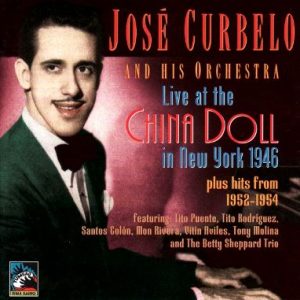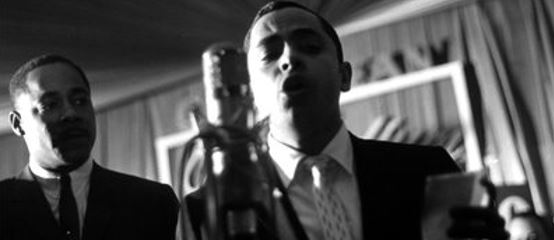This post is also available in:
 Español
Español
This month we commemorate the birthday of Latin music great Tito Rodriguez by remembering his time with José Curbelo. Tito would’ve been 96 years old this January.
Sang with Bandleader José Curbelo
After serving in the US Army during WWII, Tito Rodríguez landed as a singer of the José Curbelo Orchestra in 1946. That year he recorded a live album with Curbelo in which he was briefly a bandmate of Tito Puente.
After the war, Puente was discharged from the Navy and began studying composing as well as freelancing to pay the bills.
Puente made some arrangements for the great maestro Curbelo. He ended up participating in the 1946 recording made live at the China Doll in New York City.
The Friendship of Rodríguez and Puente
Tito Rodríguez was eventually fired by Curbelo for dating one of the dancers of the club they played. The Japanese girl would end up becoming his wife.

Now unemployed, Rodriguez formed his own band in 1947. Initially, he named his band “Los Diablos del Mambo“. He would later evolve that to “Los Lobos del Mambo“, only to eventually end with Tito Rodriguez and his Orchestra.
Puente followed his friend by forming his band about a year later. Since both became premier bands in the Latin music scene, people began speculating about a feud that close friends of both said never really existed. Both bands became among the best in Latin music along with Machito and his Afro Cubans.
Video of “Repica el Timbal”
One of the songs on the Jose Curbelo recording at the China Doll was “Repica el Timbal”. The song features Tito Rodríguez at vocals and Tito Puente on timbales.
For this and other songs that featured Tito in the timbales, Curbelo would bring Puente to the front with his timbales. Tito Puente would perform at the front of the band standing up. This allowed him to also showcase his dancing skills while playing. Up until then, timbaleros played in the back and sat down.
This is quite a historic recording.
“Avísale a Mi Contrario”
One of the songs people attributed to the Rodriguez-Puente feud was “Avisale a Mi Contrario”. This song was written by Ignacio Piñero back in 1906. So making it a “tiradera” song between the two is not true. However, the rumor helped make the song one of Rodriguez’s biggest hits.
Here’s the video of the song.
Happy Birthday Tito Rodriguez!


Hello…. Thanks for remembering the great Tito Rodriguez.
Prior to Tito Rodriguez bring hired by Jose Curbelo, TRod became a vocalist in a dance orchestra led by Swing trumpeter Louis “King” Garcia, upon Tito’s discharge from the U.S. Military in 1944. Garcia had formed a “Rhumba” dance band 2 years earlier and at one point was the house band for a local promoter at the Hunt’s Point Palace. Tito was to have replaced Garcia’s initial vocalist, who was none other than “Chivirico” Davila. Garcia expressed to Tito to listen to the way Chivirico sang and, thus, Chivirico was an influence in Tito’s early career (trust your ears and listen to them both sing). With Tito Rodriguez on lead vocals, the Garcia outfit performed at dances on Broadway’s Hotel Diplomat, and even performed in a hotel in Puerto Rico. In 1945, Tito Rodriguez emerges leading his very first small ensemble at the Havana Madrid on Broadway, strictly as a “relief” band for the more well known bands of the era like Pupi Campo and Juanito Sanabria. That same year he rejoins the orchestra led by Noro Morales (after an earlier pre-War stint) and appears in a short film (soundie) playing maracas with the Noro Morales orchestra, who were accompanying Diosa Costello on vocals. The title of the film was “Ella.” It’s from the Morales band, who shared the bill with the Jose Curbelo orchestra at a cabaret known as La Conga, that Curbelo recruits Tito Rodriguez. In actuality, when the China Doll opened in 1946, it was on the site of the very same La Conga cabaret. Ironically, when China Doll opens, La Conga reopens under new management at another nearby location and, a year later, the China Doll would close and reopen/relaunch on the same site of where the new La Conga had been. Talk about history repeating itself.
BTW-The Two Tito’s playing together with the Curbelo orchestra would mark the 2nd time they would integrate an orchestra simultaneously. The first time was in 1940 with the orchestra led by Johnny Rodriguez, the older brother of Tito Rodriguez.
Best,
Richard Blondet
Richie,
This is a delightful comment full of interesting historical facts that I didn’t know. Very enlightening.
The 40’s was a defining decade in Latin music in NYC.
Machito arrived and formed his band. The two Tito’s flourish and end the decade with their own bands. Chano joins Dizzy. And the Palladium emerges as the main venue for Latin music.
Thank you for sharing your knowledge of this era.
Héctor
Hello Hector,
Just catching your response now (3 years later).
I totally agree and, in fact, more than just being a personal opinion, it can be PROVEN that the 1940s is when Afro-Cuban dance music reached its most visible mainstream level in the Americas. Cuban Popular Music permeated mainstream films, prestigious theaters, cabarets where the elites could be found, mainstream broadcast radio played this music, North American artists recorded it, corporations who manufactured commercial goods contracted Latinx artists as Noro Morales, Perez Prado, Machito, Pupi Campo, Miguelito Valdes, etc, to endorse their products. At one point, in the Times Square area of Manhattan in NYC, every single Cabaret AND Theater on 8th Avenue, Broadway, 7th Avenue & 6th Avenue, between 57th Street to 42nd Street featured some form of Latin American or Iberian (Spain) entertainment. As much as West 52nd Street between Broadway and 6th Avenue is heralded as a historic Jazz “way” during the late 1940s and 1950s, West 52nd Street along the Broadway corridor had been ground zero for Afro-Cuban music since 1935 all the way through the 1960s, when the ballrooms and theaters began to make way for the discotheques.
I personally consider the 1920s and ’30s as the most important decades for the music. But the 1940s is when the music achieved its highest level of prominence ever. Including overshadowing the Mambo era of the 1950s.
Saludos!
[…] 1960 Tito Rodriguez and his orchestra were still at the top of their game. They decided to record this album in October […]
[…] at the time (and to this day) that could successfully release an all-boleros album. The maestro Tito Rodriguez had perfected the art. However, it was clear how difficult it was to emulate that act. Cheo […]